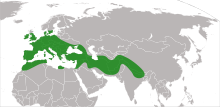Arum
| Arum | |
|---|---|

| |
| Arum palaestinum | |
| Scientific classification | |
| Kingdom: | |
| (unranked): | |
| (unranked): | |
| Order: | |
| Family: | |
| Subfamily: | |
| Tribe: | Areae
|
| Genus: | Arum |

| |
| Range of the genus Arum. | |
| Synonyms[1] | |
| |

Arum is a genus of flowering plants in the family Araceae, native to Europe, northern Africa, and western and central Asia, with the highest species diversity in the Mediterranean region.[1][2] Frequently called "arum lilies", they are not closely related to the true lilies Lilium. Plants in closely related Zantedeschia are also called "arum lilies".
They are rhizomatous, herbaceous perennial plants growing to 20–60 cm tall, with sagittate (arrowhead-shaped) leaves 10–55 cm long. The flowers are produced in a spadix, surrounded by a 10– to 40-cm-long, coloured spathe, which may be white, yellow, brown, or purple; some species are scented, others not. The fruit is a cluster of bright orange or red berries.
All parts of the plants including the berries are poisonous,[3] containing significant amounts of calcium oxalate as raphides.
The genus name is the Latinized form of the Greek name for these plants, aron.
Species
Formerly placed here:
- Arisaema triphyllum (syn. Arum triphyllum)
- Dracunculus vulgaris (syn. Arum dracunculus)
- Typhonium venosum (syn. Arum cornutum)
References
- ^ a b Kew World Checklist of Selected Plant Families
- ^ Govaerts, R. & Frodin, D.G. (2002). World Checklist and Bibliography of Araceae (and Acoraceae): 1-560. The Board of Trustees of the Royal Botanic Gardens, Kew.
- ^ Nelson, L. et al. (2007) Handbook of Poisonous and Injurious Plants. New York Botanical Garden.
